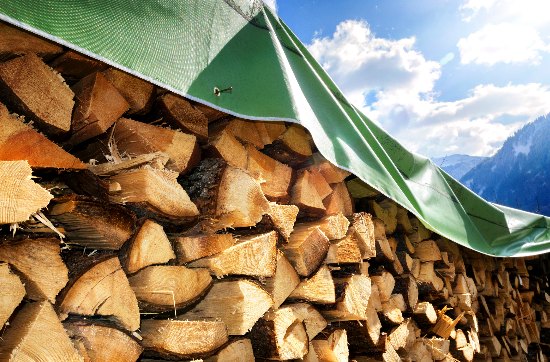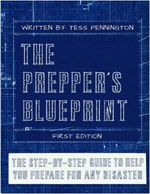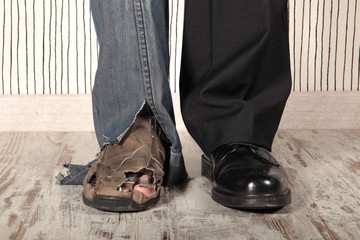This article was originally published by Jeremiah Johnson at Tess Pennington’s ReadyNutrition.com
Tess is the author of The Prepper’s Blueprint: How To Survive ANY Disaster

I’m a big believer in using the daylights out of tarps, or tarpaulin, if you prefer. Very versatile, and they can benefit you in a lot of ways as a homesteader, prepper, survivalist, and in your day-to-day existence of just being prepared. There are a slew of different types, so we’re going to cover not so much the types needed, but the job they’ll be employed for. In this manner (and as there are plenty of variances from store to store), you’ll be able to find out what one you need by identifying how you will utilize it. Let us begin!
You should try to find tarps with a good UV or Ultraviolet rating. You’ll just have to search it out by product. You can find these even in your friendly neighborhood Wal-mart, although they have a problem with theirs. They usually make them “Jupiter-2/Lost-in-Space” grey with the other side being either brown or blue. These colors are worthless in terms of staying concealed…the “earth tone” principle I have reiterated continuously over the years.
Try to stick with your colors and base them on the season. There are tarps that are white (obviously for winter, or if you’re in secure enough surroundings, summer…for the purpose of reflecting the sunlight), as well as earth-tones, such as dark green, brown, or camouflage patterns. (Editor’s note: You can also get one that is reversible white/brown). You want your tarps to have sturdy grommets…holes through which you can fasten a hook or run a line/rope through. In addition to this (to digress slightly), there is a grommet kit you can pick up at happy Wal-mart for almost nothing. Get it. The reasons: you may have to fix a grommet that has busted out of your tarp, or make a tarp out of some type of plastic. We’ll go more into the second reason later.
10 Emergency Preparedness Uses for Tarps
1. Shelter: a smaller one (such as a 6’ x 8’, or 8’ square, or so) can be used as either a protective overlay for a lean-to, or stretched out with bungee cords, 550 cord, or such for a tent/four-cornered rain fly. Larger tarps, of course, can be constructed into larger tents. Here is where the UV factor comes into play so that you will not be a sunburned “baked potato” under a tarp that can get pretty warm in the summertime.
2. Ground cover: under your tent, to help prevent moisture from coming under the floor. Also, spreading it out (folded or unfolded) under your sleeping bag can help as a moisture barrier, if you don’t have a Gore-Tex cover for the bag or an inflatable pad.
3. Protect the Supplies: I use them all over my property just to protect and cover up woodpiles. They’ll wear out after about 3-5 years, but so what? They aren’t very expensive, and they work to keep my woodpiles dry during the wintertime. You can use them for other things, such as palleted supplies, augments for existing structures (a “snow-fly” to deflect snow if you have a tent of some sort on your property), and so on.
4. Quick Fixes: The friendly tree in the front yard just became “unfriendly” and smashed a giant hole in your ceiling. Obviously, a tarp is not a long-term solution, but when it’s -10 degrees Fahrenheit outside and snowing? A “stop-gap” is preferable to having a gaping hole where the “Snow Ghost” could enter through your roof. Another “gem” is where Mr. Tree reaches out his stinking branch and delivers a left jab to one of your windows. Chop his branch off…after you close off the window with the tarp…once again, a “quick” fix that you don’t want to leave in place as an “heirloom” for the next two generations.
5. For a temporary cistern: I just did a piece on how PVC pipe can be used to transport water to your camp. Well, if you dig a small depression, you can use tarps and/or plastic sheeting to cover the ground and thereby trap the water for your use later on. Be sure to place some stones on the bottom, and around the edges of your newly-made depression/cistern, to keep the tarp from shifting and thereby prevent water loss.
6. Protect your Gear in the Field: When you’re off on that hike away from your camp, and you’re not carrying your rucksack, you can cover the ruck with a tarp to keep your gear drier.
7. Camouflage a vehicle: Seasonally-dependent, of course, and also to be “blended” with the terrain. You may have to squirrel away a vehicle from view. The first factor: obviously, a woodland-camouflaged tarp would stick out when the entire ground is covered with several feet of snow. If you have a white tarp for the vehicle, the color may be fine, but you have to blend it in: an 8’ by 4’ white “lump” will not be overlooked in the middle of a flat field. Use common sense and your eyes. If it jumps out at you, it will jump out at another hunter-gatherer hungrily plodding toward your location.
8. To collect rainwater: What better way to replenish those canteens and drinking jugs? Follow that principle: use the water and top off on your water carrying vessels as soon as you can. Bungee cords work the best to make this happen. Stretch out your grommeted tarp, and leave only a slight angle with the tarp. This will ensure it doesn’t pour off too fast. You can lift up on that lower edge and pour away when it starts to rain…it works pretty fast. The only thing that will limit you here will be the number of containers you have to catch it when it comes.
9. As a “quick fix” for a temporary cache: Yes, you may need to squirrel some gear or supplies away in a cache. Reason? Perhaps a medical emergency occurs, and you can’t haul out all of the gear and supplies with you…caching them is the only way to preserve them. You can emplace a hasty cache, and cover the supplies up with the tarp, or wrap them up in it, and then take your loved one or yourself to the doctor. Just make sure you know exactly where you cached the stuff.
10. In a medical emergency: as a temporary shelter, or even a field-expedient litter (if you have enough people) or for a “drag” type of litter…this latter being especially careful not to further injure the person.
Lastly, as I mentioned earlier, by picking up that grommet kit, you will not only be able to make repairs on busted grommets, but you will be able to construct a “field-expedient” tarp of your own. Check out the material you are considering using. There is a ton of plastic sheeting out there. You want to use something that doesn’t have a tremendous amount of “off-gassing,” that exudation of noxious and/or obnoxious fuming…the smell of the plastic. You also want to be able to utilize what you find…so try to find something durable. Construction/contractor trash bags are very sturdy and thick, indeed. This may do in a pinch. Also, that tent that the bear clawed through and got Uncle Ed last year? Or if it was just Mr. Tree dropping one of his branches to give the tent a skylight…relax. Use a razor/utility knife and cut it into a tarp. The floor is good for this, as it’ll be one piece. Set your grommets accordingly, and put it to use.
We’ve outlined some ideas here. Tell us what you have used them for: that’s how the community benefits, from good feedback and input. Quality is important, but as I illustrated with the woodpile tarps I use, nothing lasts forever, and it is best to gauge it remembering that all things wear out with the passage of time.
About the Author
Jeremiah Johnson is the Nom de plume of a retired Green Beret of the United States Army Special Forces (Airborne). Mr. Johnson was a Special Forces Medic, EMT and ACLS-certified, with comprehensive training in wilderness survival, rescue, and patient-extraction. He is a Certified Master Herbalist and a graduate of the Global College of Natural Medicine of Santa Ana, CA. A graduate of the U.S. Army’s survival course of SERE school (Survival Evasion Resistance Escape), Mr. Johnson also successfully completed the Montana Master Food Preserver Course for home-canning, smoking, and dehydrating foods.
Mr. Johnson dries and tinctures a wide variety of medicinal herbs taken by wild crafting and cultivation, in addition to preserving and canning his own food. An expert in land navigation, survival, mountaineering, and parachuting as trained by the United States Army, Mr. Johnson is an ardent advocate for preparedness, self-sufficiency, and long-term disaster sustainability for families. He and his wife survived Hurricane Katrina and its aftermath. Cross-trained as a Special Forces Engineer, he is an expert in supply, logistics, transport, and long-term storage of perishable materials, having incorporated many of these techniques plus some unique innovations in his own homestead.
Mr. Johnson brings practical, tested experience firmly rooted in formal education to his writings and to our team. He and his wife live in a cabin in the mountains of Western Montana with their three cats.
Tess Pennington is the author of The Prepper’s Blueprint, a comprehensive guide that uses real-life scenarios to help you prepare for any disaster. Because a crisis rarely stops with a triggering event the aftermath can spiral, having the capacity to cripple our normal ways of life. The well-rounded, multi-layered approach outlined in the Blueprint helps you make sense of a wide array of preparedness concepts through easily digestible action items and supply lists.
Tess is also the author of the highly rated Prepper’s Cookbook, which helps you to create a plan for stocking, organizing and maintaining a proper emergency food supply and includes over 300 recipes for nutritious, delicious, life-saving meals.
Visit her website at ReadyNutrition.com for an extensive compilation of free information on preparedness, homesteading, and healthy living.










0 Comments